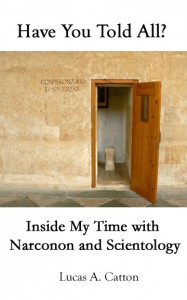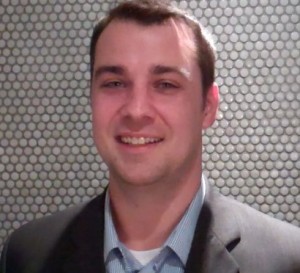It’s been stunning to see the Narconon drug rehab network emerge in the past year as perhaps Scientology’s single biggest crisis of the many that it faces.
And key to that growing problem for the church has been Lucas Catton, formerly president of Scientology’s flagship rehab facility in Oklahoma, Narconon Arrowhead.
Last year, Catton came forward to tell us about Narconon’s questionable business practices in the wake of several patient deaths that have led to criminal investigations and civil lawsuits. Earlier this month, in part because of Catton’s whistleblowing, the CEO of Narconon Arrowhead was stripped of his drug counselor certification.
Like other former Scientologists who have written self-published memoirs, Catton was in a remarkable position to witness some of Narconon and Scientology’s worst behavior. And his book makes for some startling reading.
Narconon’s problems have never been worse, but they were a long time coming.
In 2004, a series of devastating articles in the San Francisco Chronicle by Nanette Asimov (niece of the science fiction author) led to a state investigation that banned Narconon materials from California public schools. Despite that setback, Narconon continued to expand, becoming very lucrative for Scientology — to which it pays licensing fees.
Catton estimates that Narconon Arrowhead — the largest single facility — reached its maximum size in 2005, but since then, it’s been getting harder to fill all of its beds. He estimates that it’s gone from 250 patients in 2005 to 150 today.
Things really started to change in April 2012 when David Edgar Love, a former Narconon patient and employee, convinced Quebec health authorities to shut down the Scientology rehab facility there. It had taken an enormous, multi-year effort by Love to convince Canadian officials to take a harder look at Narconon’s program — which is essentially the same training beginning Scientologists go through.
Then, in July, tragedy: the overdose death of Stacy Dawn Murphy, 20, was Narconon Arrowhead’s third patient death in nine months. The local media jumped on that story, and suddenly Narconon was at the center of a firestorm.
Around that time, we received an e-mail from someone who reminded us that he had tried to pass on information about Narconon to us earlier. It was Lucas Catton, and as Narconon Arrowhead’s former president, he had a lot of inside information. He was also vulnerable: he had left Scientology but his ex-wife hadn’t, and they had a young daughter they were sharing custody of. It was a lousy situation for Catton to be in, but he wanted to tell us about Narconon’s many problematic practices.
For example, he told us that Narconon Arrowhead’s licensing had a very contentious history, and a change in law had made it extremely vulnerable. With the deaths and the subsequent media attention, Catton said, Narconon’s officials had to be freaking out. We used his words in a story without identifying him, and assumed that Catton might never go on the record because of the precarious spot he was in.
Just a week later, he stunned us by outing himself with an Internet declaration about leaving Scientology. After he posted it, he notified us, and after discussing it with him, we then revealed that he was our source on Narconon Arrowhead’s licensing problems.
After that, things only got worse for Scientology. The 2008 death of Patrick Desmond at the Narconon in the Atlanta area had produced a wrongful death lawsuit that turned disastrous last summer for the rehab facility and its executive director, Mary Rieser. In August, we wrote that court documents showed Rieser had blatantly deceived a Florida drug court about the nature of the facility when Desmond was sentenced there. The judge in that case took the extraordinary step of declaring Rieser a liar and handcuffing Narconon Georgia’s legal defense.
In October, Atlanta’s local media teamed up in a ferocious investigation of Rieser and Narconon Georgia that is still ongoing. (Just days before the lawsuit was set to go to trial in February, Narconon caved and settled with the Desmond family for an undisclosed sum. By then, however, the state of Georgia had confirmed that it had opened a criminal probe over alleged insurance fraud at the facility.)
 Catton, meanwhile, made himself available for television interviews and court testimony, and he very quickly wrote his book. In recent weeks, he’s been joined by another former Narconon employee, Eric Tenorio, whose revelations have been similarly explosive: because of formal complaints filed by Tenorio and Catton, Narconon Arrowhead CEO Gary Smith had his Certified Chemical Dependency Counselor (CCDC) certification revoked — as did Rieser and other Narconon employees.
Catton, meanwhile, made himself available for television interviews and court testimony, and he very quickly wrote his book. In recent weeks, he’s been joined by another former Narconon employee, Eric Tenorio, whose revelations have been similarly explosive: because of formal complaints filed by Tenorio and Catton, Narconon Arrowhead CEO Gary Smith had his Certified Chemical Dependency Counselor (CCDC) certification revoked — as did Rieser and other Narconon employees.
We broke that news on March 7. And last week, Catton and Tenorio were flown to New York by NBC’s Rock Center for what should be a meaty followup to the show’s initial report about Narconon’s deaths last August. While they were in town, we met the two whistleblowers and read Catton’s book, titled Have You Told All?
It should take its place alongside Marc Headley’s Blown for Good, Jeff Hawkins’ Counterfeit Dreams, Amy Scobee’s Abuse at the Top, and Nancy Many’s My Billion-Year Contract as another eye-opening insider’s expose of Scientology’s obsession with money and control.
Catton’s story is not just about how he rose to become the figurehead and PR specialist for Narconon’s flagship operation, but also how, as a former patient, he got sucked into Scientology itself.
Sent twice to the Oklahoma center because of binge drinking when he was 19 and 20, Catton then became a staff member and impressed CEO Gary Smith with his ability to talk up Narconon with the public. That also included working with celebrities, and Catton watched as Scientology sent luminaries like Tom Cruise, Kelly Preston, and church leader David Miscavige to visit the Oklahoma facility. Catton also spent much of his time trying to convince other rehab programs in the state that Narconon was legitimate, and also dreamed up ways to sway lawmakers and other policy makers.
But Scientology itself was proving disastrous for Catton. Especially in 2007, when he (and everyone else) was forced to buy multiple sets of “The Basics” — reissued L. Ron Hubbard books and lectures that sold for $3,000 a set. Frustrated by how much money he was constantly hit up for, Catton began to wonder if Scientology itself was the problem. Gradually, he became aware of all the negative press about Scientology and Narconon.
We told Catton that he does a particularly good job describing what happened next — his infuriating years attempting to distance himself from Scientology, and how that ended up ruining his marriage to a woman who wanted to remain in the church. Like others, he found that it wasn’t easy to extricate himself from the clutches of Scientology and its constant need for more cash.
“The hardest part is admitting to yourself that you were wrong. That, I think, is what pulls you back in,” he told us as he tried to explain what kept bringing him back to Scientology’s ethics officers.
By 2011, he’d been declared a suppressive person by the church — Scientology’s jargon for excommunication — his marriage was over, and his friends in the church began to “disconnect” from him. Fortunately, however, he and his wife — though they no longer can talk except through a church intermediary — have managed to work out their custody arrangments.
In his book Catton provides layers of new evidence to support what researchers like Carnegie Mellon University professor Dave Touretzky have been saying for years…
— Despite Narconon’s “shore story” that it is independent of Scientology, in fact the network is heavily controlled by the church.
— That control included admixture of funds, as Narconons, for example, were pressured to give up some of their budgets to buy Scientology books simply to help raise cash for the church.
— Generic-looking referral websites are in fact very lucrative fronts, as they pretend to give impartial advice, but instead push callers to Narconon, which pays a bounty of about $3,000 per new patient.
— Not only is the Narconon drug treatment program virtually the same as beginning Scientology training, the recruitment of new church members is an active goal of the rehab network.
— After 2006, Catton could no longer get answers about the whereabouts of Rena Weinberg, president of the Association for Better Living and Education, which oversees Narconon International for Scientology and is staffed only by the church’s Sea Org. Weinberg, he later found out — and as we reported in August — has spent all or part of the ensuing years as a prisoner in Scientology’s bizarre office-penitentiary at its International Base east of Los Angeles.
For Scientology watchers, there’s a lot to like about this book, and we haven’t spoiled all of its surprises for you. Catton found himself in some nutty situations during his Scientology career. Now, he’s taking a big risk by coming out so publicly against his old employer.
So far, he and his daughter are doing just fine.
—————-
SMERSH Madness: Sowing the Seeds of World Domination!
As we announced on March 1, we’re joining bracket fever with a tournament like no other. It’s up to you to decide who should be named the new SMERSH, the traditional nemesis of Scientology. Cast your vote for who’s doing more to propel the church down its long slide into oblivion!
Continuing with the Sweet Sixteen! We have another tough match.
Nancy Many wrote about her amazing Scientology experiences in her book, My Billion-Year Contract. But we were really blown away by the job the ID Network did turning her book into a docudrama this January. The show captured her incredible story, from spying for the church to suffering on the RPF. (Previously: Many defeated Paul Thomas Anderson in the first round.)
Tom Tobin and Joe Childs of the Tampa Bay Times are the deans of Scientology journalism. Their 2009 series that exposed violence at Scientology’s International Base, and their 2011 project on the money side of Scientology provided the bedrock material that most of the rest of us work from. Consummate professionals, these two quiet guys go about their work with little fanfare and never seek the spotlight. We shudder to think what their next blockbuster takeout will uncover. (Previously: Tobin & Childs got past Marty Rathbun and Mike Rinder in the first round.)
Go to our March 1 post for the latest tournament results.
——————-
Posted by Tony Ortega on March 18, 2013 at 07:00








